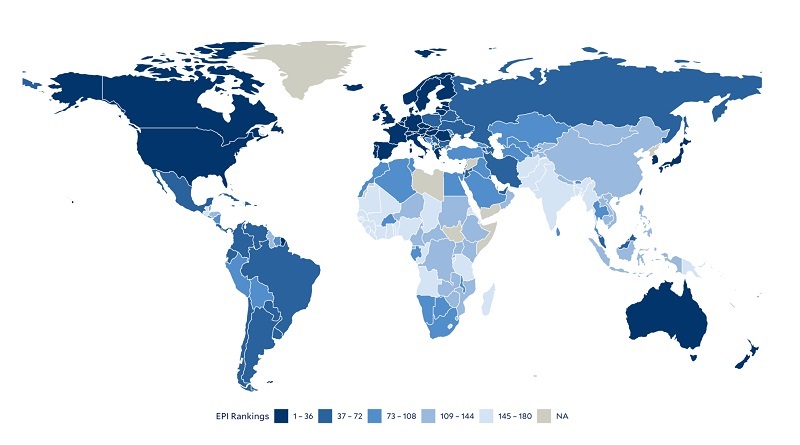How can we gauge the current state of environmental sustainability worldwide? Which countries have shown proven dedication to addressing vital environmental issues – which are lagging behind?
We caught up with Zach Wendling, Principle Investigator and Postdoctoral Associate at the Yale Center for Environmental Law & Policy, for his key insights from the Environmental Performance Index 2020.
Zach, which findings of the Environmental Performance Index did you find the most intriguing?
Denmark’s #1 rank in the 2020 EPI highlights the importance of countries making a concerted effort on all fronts to build a sustainable future. What really distinguishes Denmark, though, is its comprehensive commitment to decarbonization, rising above even its peers in making significant and substantial cuts to greenhouse gas emissions, with bold pledges of more to come.
In contrast, the United States, another wealthy democracy, places only 24th – far from being a leader.
China’s rank at 120th in the world puts it at the bottom of the middle third. It’s important to recognize the real progress China has made – environmental policy pulling it out of the bottom tier – while also seeing they still have far to go.
India, however, at 168th out of 180 countries, is a cautionary tale of how low a country can sink after decades of neglecting even basic environmental problems like air quality.
Which countries have seen the strongest increase in ranking since last year?
To compare how countries do over time, we apply our current methods to calculate what scores would have been roughly ten years ago. This lets us see who is on a long-term trajectory toward success – or backsliding.
Countries that have done a lot to move up in the rankings are Seychelles and Bahrain, who have both made significant investments in decarbonizing their small island states. Morocco, Croatia, Kuwait, and the United Arab Emirates also improved their EPI scores through expanded protection of biodiversity and habitat.
Which countries have you seen the strongest decline?
Niger, Singapore, and Guyana have all slipped substantially in their scores. Niger’s population is growing rapidly, with corresponding increases in greenhouse gas emissions from agriculture and a burgeoning oil production industry.
Singapore, likewise, is heavily dependent on its petrochemical industrial sector, doing much worse than other wealthy countries.
And Guyana’s newly discovered offshore oil and gas reserves are emitting CO2 and methane as they are explored and developed.
What is the methodology behind the Environmental Performance Index?
The Index takes 32 indicators of environmental performance from 11 categories related to human health and ecosystem vitality. We translate these indicators to a 0–100 score, from worst to best. We give each indicator a different weight and then aggregate up to a total score, which allows us to rank every country.
There are many ways how our Index could be constructed, and we are always open to advice, suggestions, or constructive feedback on how we can improve – or for others to try their own alternative calculations.
Thank you, Zach.
For details on the methodology and results of the most recent study, visit epi.yale.edu.
Curious about how different countries compare in terms of their sustainability, attractiveness, brand strength and reputation? Find out in our country observatory.


